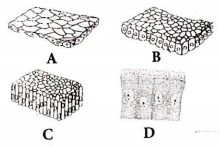 Multiple Choice Questions
Multiple Choice QuestionsIn frog heart, there are cardiac muscles which consists of fibres called
Purkinje fibres
myonemes
telodendria
columnae carnae
Malphigian tubules are
excretory organs of insects
excretory organs of frog
respiratory organs of insects
endocrine glands of insects
Inner lining of blood vessels is formed by
ciliated epithelium
squamous epithelium
cubical epithelium
columnar epithelium
B.
squamous epithelium
Inner lining of blood vessels is formed by squamous epithelium. It consists of a layer of thin, flat, scale- like cells with prominent nuclei. The cells have irregular boundaries that fit closely into those of neighbouring cells.
Ciliated epithelium is found in the respiratory tract and in the fallopian tubes of women. It helps in the movement of particles out of the body using hair like structures, cilia.
Cuboidal epithelium is found in organs that are specialized for secretion such as salivary glands and thyroid follicles.
Columnar epithelium is uni- layered. It is found in lining of most of the digestive tract such as stomach, small intestine and large intestine.
In frog chromosome number is reduced to half
when 2nd polar body is separated
when 2nd polar body is divided
when 3rd polar body is separated
when 1st polar body is separated
The figure shows different human tissues labelled as A to D. Which option gives the correct identification of the label, its location and one feature.

D-Unicellular glandular epithelium, goblet cells, secrete saliva
B-Squamous epithelium, walls of blood vessels, form a diffusion boundary
A-Cuboidal epithelium, ducts of glands, secretion and absorption
C-Columnar epithelium, lining of stomach, secretion and absorption
Pacinian corpuscles occur in the skin of certain parts of body in mammals. These are
type of glands
pain receptors
naked tactile receptors
encapsulated pressure receptors.
